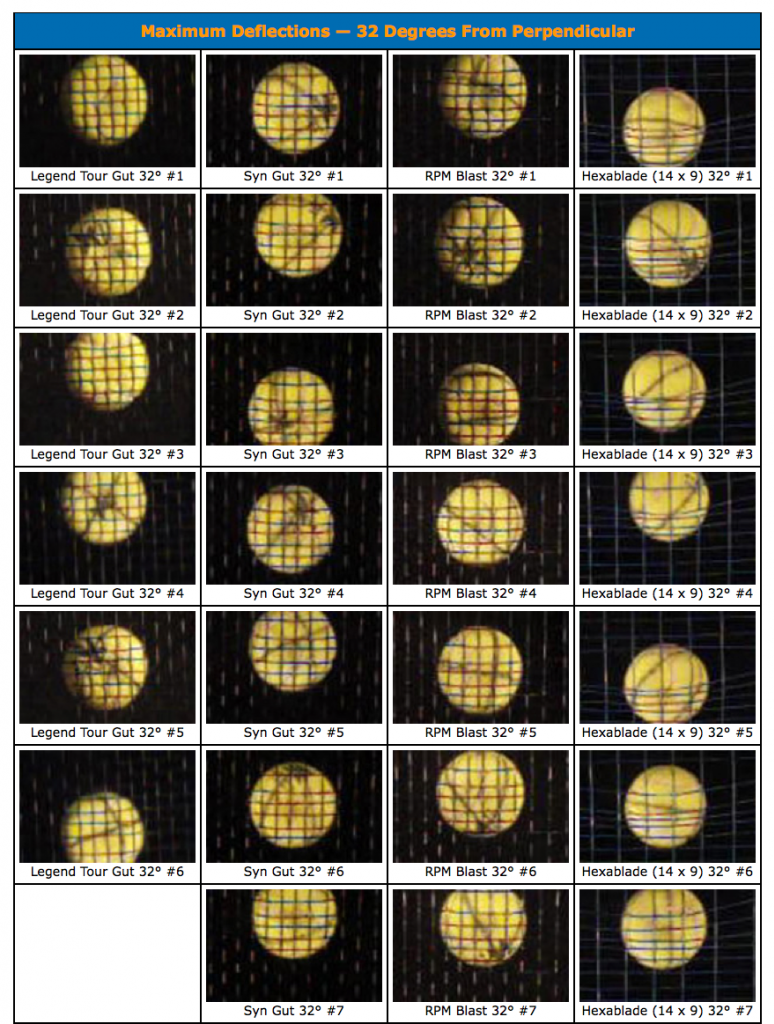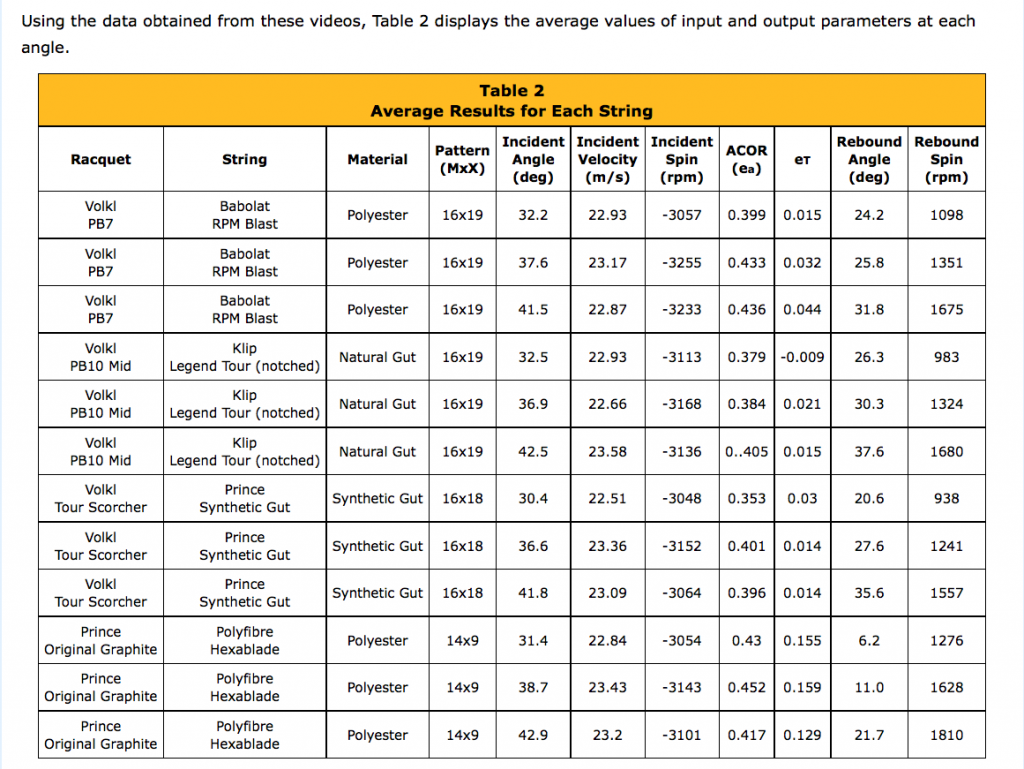Ah yes, the big gaps thing. Big gaps = ball bite = more spin. That idea has been around been quite a while. At least since the days when
Mark Woodforde played with a Frankenracquet inspired by his old Snauwert Hi-Ten built from a PS 7.5 mold with a custom
12 x 16 drill pattern.
It's big topic that could fill many chapters in a book, but I will just kick out the quickie version before heading off to bed. By the way, if it sounds remotely intelligent, it's probably just the words of Crawford, Lindsey, Brody, Goodwill or Hawke rolling around in my head. I'm just a dumb jock who reads tennis physics as a substitute for OTC sleep aids.
Ball to String Friction, and Spin : Prevailing Concepts (1980 - 2005). Players have developed dozens of concepts about how to increase spin over the past several decades. From the graphite era until somewhere in 2005-2008, nearly
all of those ideas centered around increasing ball to string friction. Out of this basic, and largely unchallenged premise, dozens of concepts have emerged. Interestingly, almost
any quality of string could be made to be consistent with
any mental imagery about ways to increase ball bite, witness:
- Thick strings have more surface area, therefore more bite.
- Thin strings dig into the ball, therefore more bite.
- Stiff strings (Kevlar, Poly) squash the ball more, therefore the ball pancakes into the string bed more, therefore more bite.
- Elastic strings deform more, so strings wrap around the ball more, therefore more grab.
- Textured, shaped, rough strings means more ball bite.
- Open patterns dig into the ball more.
- Closed patterns have more surface area contact, therefore more ball bite.
- Longer dwell times means the ball sinks deeper into the string bed, therefore the strings wrap around the ball more, therefore more grab.
- Shorter dwell times means stiffer string, therefore the ball sinks less deeply into the string bed, but the ball deforms more, therefore more ball bite.
Notice The Pattern? Increasing ball to string friction, and cooking up new (and experimentally untested) mental imagery about how to achieve that is the only game in town for 25 years.
What Happened In 2005 - 2011 : In 2005, Yoshihiko Kawazoe, and Kenji Okimoto were working on developing a spray to revive old and notched string beds. They were just two dudes trying to make a buck, with minimal interest in advancing tennis physics. They published a video on an obscure website in Japan demonstrating that strings do in fact slide and snap back as the ball exits the string bed. The entire physics community instantly took notice. It might seem intuitive now, but back then, it was a world shaker. I for one was elbow deep in all the heated debates that took place right here at TW, Mid 2005 on the subject of string movement. For the record, I was positioned on what has turned out to be the losing side of those epic debates. I had been observing the University of Sheffield study that concluded (falsely) that strings make little difference with regards to spin. Mmy thinking back then was that strings did snap back, but that the ball was long gone by the time this occurred.
Inspired by those early, low budget video postings, the ITF followed up with a flurry of studies on the matter, followed by the research currently found in the TW university by Crawford Lindsey circa 2009-2012. All came to the same conclusion. Strings that slide and snap back, create additional spin as the ball exits the string bed. We can now assume, that Wilson brought some of those published insights back to their own in house R&D for implementation, and are apparently currently seeking a patent.
On Impact Angles And Ball Deformation: In the sport of table tennis, where typical topspin strokes occur at at very extreme contact angles, and the ball does not deform, ball to paddle/rubber friction is a very, very big deal. But in the sport of tennis, top spin shots occur at racquet face angles between 0-50 degrees, and the ball deforms on impact. It is possible that if the impact angle occurs at an angle greater that 50 degrees, the ball will not bite and slide across the strings. But this situation rarely occurs except in the case of extreme topspin lobs. It has also been observed via ultra hi speed video camera studies performed by the ITF, that the if the impact forces are great enough, the ball can be squashed to nearly flat, with the back of the ball actually bouncing off the front of the ball! When you see what really happens at impact, the tennis world is a very strange and beautiful place indeed. The ball wobbles, it shakes like a bowl of jello. The ball deforms into a whole bunch of odd shapes, but what one shape it is not, is round. And yes, even novices hit the ball with enough force to cause ball to deform to roughly 40-60 percent of the original size.
What Deformation and Impact Angle Means To The Ball "Bite" Issue: You cannot have any more, or any less ball bite, when the ball is already squashed into the string bed like a bug on a wind shield. One hundred percent ball bite occurs, every time you hit the ball, no matter what strings you use. What
can be said is that there is biting a little bit sooner during the 3-5 milliseconds impact, and there is biting a bit later as the ball exits the string bed. However, this biting a little bit better as the ball leaves the string bed is important to spin production only if the mains have traveled over the crosses, leaving them positioned for the snap back. See photos
[a] provided below. Link here.
Quote [1] "String manufacturers have always marketed tennis strings according to their ability to grip the ball via sticky coatings, rough/grabby surfaces, or "biting" shapes. The underlying theory is that greater friction between the string and the ball will cause more spin. This was universally accepted as true until it was demonstrated that for all impacts less than 50 degrees away from perpendicular, the strings will bite the ball to the maximum extent possible, no matter the texture, shape, or material of the string. This is important because when biting occurs, friction ceases. This result assumes that the stringbed is laterally rigid — i.e., the strings do not move sideways, or, if they do, they do not snap back into position. This was the situation in the pre-polyester string days. As we will see below, polyester changed everything" [1] - Crawford Lindsey, How Ball to Spin Friction Affects Spin, Feb 2012. Link here.
Quote [2] "Friction is important to spin, but not in the sense that most people think it is. In the past, two assumptions were the foundation for the conventional wisdom that (1) a rough string surface creates more spin by increasing the string's bite, grab and push on the ball, and (2) that inter-string motion would lessen that grabbing and thus should be minimized. So, to gain maximum spin, the goal was to use a string with both a high ball-string friction and a high string-string friction to create a rigid surface parallel to the string bed. As so formulated, both of these assumptions have proven incorrect. First, experiments show that for a tangentially non compliant surface, the spin will be nearly the same for all magnitudes of string-ball friction for impact angles typical for tennis shots. For reasons explained below, both rough and smooth strings will produce the same spin on a laterally rigid surface. (2nd paragraph deleted for brevity) The role of ball-string friction in this process is that it influences both the amount of lateral string movement and the torque the snap-back exerts on the ball (though the magnitude of its contribution is yet to be ascertained by experiment). It is here that ball-string friction contributes to the difference in spin performance between string models, but only if the strings move. Otherwise, ball-string friction produces about the same spin for every string. And whether the strings move or not depends on the static and sliding friction between strings. [2] -- Crawford Lindsey, August 2010, Revised February 11. Link here.
corners - Feel free to jump in here on this, in case I've missed anything important with my quickie thumbnail explanation. I've noticed you have a pretty good handle on this stuff.
Photo [a] Link Here
Photo Link Here
-Jack


